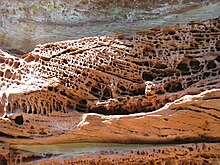



Honeycomb weathering, also known as honeycombs, honeycombed sandstone, is a form of cavernous weathering that consists of regular, tightly adjoining, and commonly patterned cavities that are developed in weathered bedrock; are less than 2 cm (0.79 in) in size; and resemble a honeycombed structure. Honeycombs also been called alveoli, lacework, stonelace, fretting, or miniature tafoni weathering.[1][2] The size at which honeycombs are differentiated from tafoni varies greatly in the scientific literature and lacks an official consensus.[3]
- ^ Bruthans, J., Filippi, M., Slavík, M. and Svobodová, E., 2018. Origin of honeycombs: Testing the hydraulic and case hardening hypotheses. Geomorphology, 303, pp.68-83.
- ^ Paradise, T.R., 2013. Tafoni and other rock basins. In: Shroder, J. (Editor in Chief), Pope, G.A., (Ed.), Treatise on Geomorphology. Academic Press, San Diego, CA, vol. 4, Weathering and Soils Geomorphology, pp.111–126.
- ^ Groom, K.M., Allen, C.D., Mol, L., Paradise, T.R. and Hall, K., 2015. Defining tafoni: re-examining terminological ambiguity for cavernous rock decay phenomena. Progress in Physical Geography, 39(6), pp.775-793.